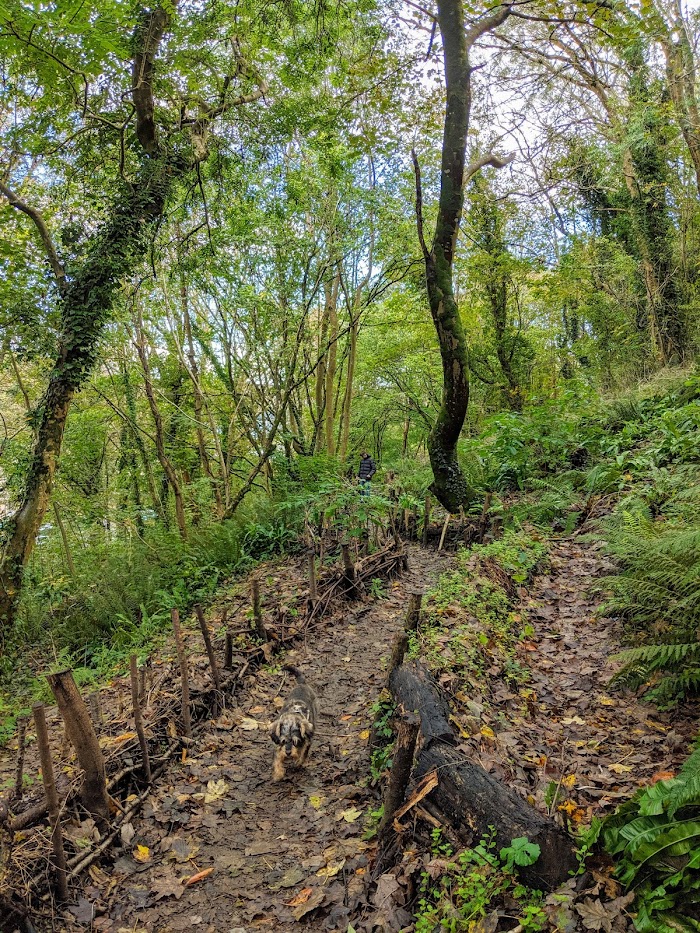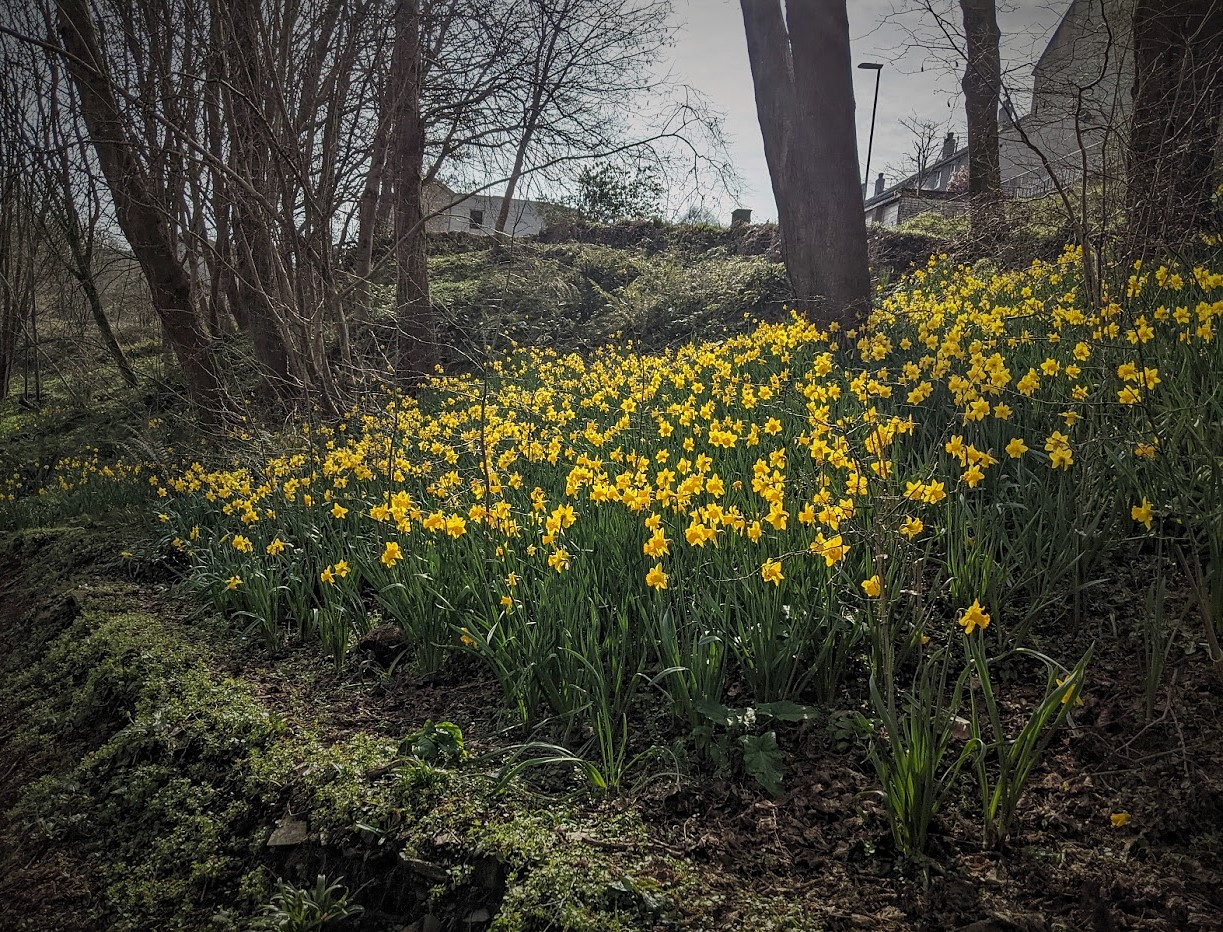
Jon Foster (63) is the one-man-army, responsible for the transformation of Coombe Woods, hidden away in the centre of Saltash. He began working there almost 15 years ago, as an ‘outlet’ when he started to suffer mental health problems, as a result of caring for his elderly mum who had developed dementia after the death of his father.
I spoke to Jon to find out what led him to embark on such a long and difficult project. Here’s what he told me….
“The only pathway, when I first started, was the main one running through the middle, which I’ve renamed Willow Walk, after my niece – that was the only thing that was there. I had dogs, and so I used to walk and cut through everywhere, and there were many fallen trees, so I just decided that I would start to clear away some of them.”
I asked whether he needed to get permission? “I just went down and did it, and somebody reported me for causing criminal damage. So, then I had to deal with Saltash Council, Cornwall Council, and the police. I couldn’t handle the fact that I was trying to do something for the community, and was being pulled up for it. But in the end, a lady from Cornwall Council came – Jenny Heskett, who still oversees all the little places like Coombe Woods throughout Cornwall. She came and asked if I’d like to be volunteer ranger. That’s basically where it all started. Jenny said I had to get a ten-year plan of what I wanted to do with it.”
“So, I drew out an initial plan of what I wanted to do, and then I had to send it to the Council so they know what I’m doing. It started off with just clearing certain places as I wanted to put pathways in, and the only way I could define them was to clear everything. As I was clearing, I’d put it on the edge of a pathway. There’s nothing that comes out of the wood, foliage, or anything. If I cut or coppice trees, then the long bits go into making hedges. I’m making live hedges, but they’re one of the things that takes 3-5 years, folding, bending, and clipping it all together. I use willow twigs to tie things in, so everything’s all natural. “
Have you been offered any funding to help towards the project? “I don’t get any funding from the Council at all. The only thing I do get, once a year, is called the Saltash Community Fund, and I have to apply for that. If you’ve seen the bird and tree signs down there, they’re marked from Saltash Community Fund. They provided me with the money for the plaques, but everything else there is self-funded. This year I’ve been selling reindeers and birdboxes, which I make in my shed to raise more funding. And of course, I’ve put all the fairy houses as well.”
I asked Jon if he has anybody to help him when he’s working? “Sometimes I can call on friends, or my brother-in-law. With the bird-boxes it takes three of us to put them up. One holding the ladder, one up the ladder and one passing up the tools and boxes. I started off with just 5 or 6 which I put up out of curiosity. But it took 3 of us to put up 68, taking down ones which needed replacing, or cleaning out. In January I will go around and clean them all out and replace or renew them as need be. It will take 3 of us again. I’ve probably got 40% occupation (in the bird-boxes), as it takes them a while to get used to them. Hopefully the young from last year will come back.”
“I’m not allowed to use chainsaws, so a lot is done by different sized bow saws. There have been several trees that have fallen, and if they’re dangerous the Council will come and cut them up, and then leave them in lengths so I can re-use them. I even made a sculpture from one of the fallen trees, which is now on show at the Ashtorre Rock. It’s made from cherry and I called it The Family. I even used the steel for the base that I found in the woods – it took me 8 years to finish.”
“90% of everything done down in the woods is done by me. There are also a few natural springs, which I have to keep clear, because they run across the pathways. The actual stream was man-made many years ago. It runs down from Warfelton Field, and eventually drains through the woods. There used to be a bridge halfway up, but it was burnt down, then replaced, then burnt down again. It’s taking me all this time to try to get the Council to reinstate it, but’s all about being able to get finances, and the Council will only allow it if their architects and planning people plan it all out, because there’s a lot of erosion there in this particular place. It’s taking a long time but I WILL get it in!”
So, do you thinks you’ll be working down in the woods forever, as it looks like a never-ending project to me? “Yes, I love it, I absolutely love it down there. I walk in places that other people don’t walk. Yesterday, when I was there, I saw the pink primroses. With the help of all the Saltash schools, 670,000 bulbs been planted in the past 14 years. So, if you go down in Spring, you’ll find lots of places with daffodils and tulips and snowdrops. I work the clearings out on a 5-year cycle, then leave them for up to 6-7 years.”
“All the pathways have been planned, because on one side of the river we’ve got foxes and the other side there’s badgers. They both go down to the river at different places. You can see in spring and summer where they cut through, to go down to the water to drink. Since I’ve been doing the woods, the birds, and bees and other species are now coming back. We’ve got jays, buzzards and owls. There are two kinds of woodpecker. Years ago, I built a pond at the bottom which I kept there for about 7 years but it kept getting silted up. I used to spend weeks digging it all out. It was initially to get kingfishers back because there did use to be some down there. I’ve had egrets nesting, lots of squirrels. There are still loads of jobs I’ve got to do down there, which are ongoing.”
“The thing that upsets me, is that I can’t get anybody interested to take it on. Although I still have the enthusiasm, I don’t have the strength to carry on just doing things, and I need somebody younger that I could train. But as it’s voluntary, it’s hard to get anyone interested. I’d really like an apprentice who could also come up with some new ideas.”

“When I first started the project, I had 5 or 6 people following on my Facebook page, and before lockdown a few hundred, but now I’ve got about 2500. I update the page occasionally, but most people who visit the woods now are locals, dog walkers and families and they can see how much work has been done there. School children visit too. The biggest class I’ve had was 36 seven-year-olds from Brunel School. They come to plant bulbs and then once they’ve left, I’ll go over just to make sure they’re covered. Then they come back in the spring to see what they’ve planted. They all have forest school and green space environmental things now to get them involved in nature.”
“It’s a bit bare at this time of year, but there are still things to see. The fungus, the sulphur caps. That’s my next project – to get the different fungus put on one of the plaques.”
John has also planted thousands of trees since he first began the project, I asked what they were. “The new trees planted are Scottish pine, I put 30 in but none have taken. About 5 years ago my daughter contacted the Woodland Trust and I had 3500 saplings from them which I planted. Oak, hawthorn, blackthorn, hazel, silver birch, beech, rowan, ornamental cherries, and probably about 1200 of those have taken. I planted the blackthorn two or three deep so I can make hedges from them. All trees the Woodland Trust recommend. So, every year it looks different. Where you see the hedges today, they were put in three or four years ago. They rot down gives homes to insects and amphibians, the birds all come back and everything goes around in a circle. It’s become a big eco space where there are far more birds and animals than there were when I first started.”
So do you know what the next job will be? “I’m walking around with the dogs daily, it’s pretty bare, but I’ll look at a place and think I haven’t done that for a while. There are lots of self-seeded sycamore on the slope at the bottom, and I want to take some out so they have some space. The woodpeckers use the dead trees, so you’ve always got to be mindful of which birds use the trees. If you took down every dead tree, you probably wouldn’t have as much life there, as things live under the bark, it’s its own ecosystem. There are some ewe trees which are about 50-60 years old, but they grow really slowly outwards, not upwards.”
I ask how do you learn how to do all this stuff? “Either from a book or online, and sometimes I do get things wrong, but then I learn from the mistake and re-think. I’ve had no tuition; it’s just been a lifetime of learning. I’ve lived here in Saltash all my life, so I’ve seen it grow. I’ve still got lots of things that I want to do, and I do still suffer from depression, but I’ve decided that I’m going to do more, because if I don’t do it now, I’m never going to do it!”
With Jon’s positive attitude and dedication to his beloved project, I have no doubt we can expect to see him down in the woods for many more years to come, and we will enjoy witnessing the fruits of his neverending hard work.

